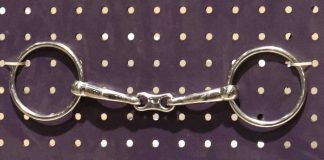
You’re in the midst of a hotly contested hunt seat equitation class. Thankfully, your horse is listening to your aids and you’re zipping along confidently at the posting trot. And then the judge calls for the sitting trot. Gulp. Do you merely stop posting and sit, maintaining the same working pace? Or do you collect your horse’s stride, slow him almost to a jog and then sit?
“I see the collected sitting trot and sitting the working trot as two completely different tests,” says United States Equestrian Federation judge Liz Adler. A past hunt seat equitation champion herself, she acknowledges that sometimes exhibitors are confused when it comes to the sitting trot. “But they should listen carefully to what they’re asked to perform. For a collected sitting trot, I absolutely want to see just that: collection. The rider should be effective at applying her leg while keeping a feel of her horse’s mouth, so that she, in essence, ‘compacts’ her horse’s length of stride and thereby slows his pace.”
On the other hand, if equitation riders are asked to simply “sit the trot” it should be assumed that it’s a working trot. There shouldn’t be much difference, if any, in the horse’s pace or length of stride from his posting trot. While Adler has sympathy for those riders whose horses are about as comfortable as sitting atop a bucket of rocks, she can only judge what she sees.
“Perhaps a more talented or more polished rider could indeed sit that bouncy horse’s trot,” she offers. “Maybe what they need is to work harder.”
To gain that improvement, Adler offers that the old tried-and-true method of practicing without irons is the best tip. While riding without irons, the rider must focus on maintaining correct leg position.
“One problem riders have in trying to sit either trot [working or collected] is that they try to hold themselves in the saddle by gripping with their thigh and knee. They begin to pivot on their knee so that their lower leg is forced away from their horse. They may look tight and secure from the side,” she explains, “but as they pass by on the rail it’s apparent that their lower leg is several inches off their horse’s side.”
Riding without irons strengthens the proper leg position, providing there’s someone on the ground reminding the rider not to let their leg become too relaxed.
At the opposite extreme are the riders who seek security by hiking their lower leg up. Pretty soon they’re taking on the appearance of a jockey as they attempt to hold themselves in place.
“Instead, over time, riders should learn to feel when their lower leg is correct. There’s no shortcut. Only with a tight leg, kept in its proper position, can you really sink deep into the saddle and be an effective rider at the sitting trot.” She adds, “At both sitting trots.”
Further Reading
Perfecting the Posting Trot
Hunt Seat Equitation Challenge: Sitting Trot
Improve Your Hunt Seat Equitation







Thanks for posting this article. I ride western so i know about how hard it is to have to sit at a trot. I want to learn english and have been working on posting. I had no clue that in English style that there is a sitting trot. Thanks so much Horse Channel.~Melissa
Thanks you so much for this article. I really hope to improve my sitting trot with the help of my trainer and this article.
Lots of good advice. I always like reading what judges are looking for. Thanks!
Sometimes you’re lucky with a horse that’s easy to sit but sometimes it feels as though you’re on a trampoline.
I always have to post.
read the document at http://www.rogerguevremont.com/_RG/LearningTrot.htm
sitting trot without the bounce